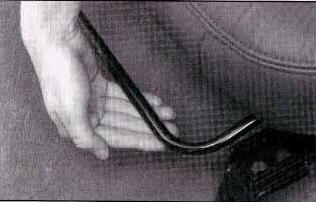
Corvette Intelligent Owner's Manual
Seats and Restraint Systems
Here you’ll find information about the seats in your Corvette and how to use your safety belts properly. You can also learn about some things you should not do with air bags and safety belts.
Sport Seat (Option) Reclining Seatbacks
How to Wear Safety Belts Properly
Safety Belt Use During Pregnancy
When should an air bag inflate?
What makes an air bag inflate?
What will you see after an air bag inflates?
Securing a Child Restraint in the Passenger Seat Position
Checking Your Restraint Systems
Replacing Restraint System Parts After a Crash
This part tells you about the seats -- how to adjust them, and also about reclining seatbacks and seatback latches.
Manual Front Seat (Option, Passenger Only)

Pull up on the lever in front of the seat to unlock it. Slide the seat to where you want it. Then release the lever and try to move the seat with your body to make sure the seat is locked into place.
1-2
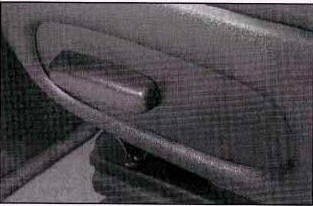
The switch for the power seats is located on the side of each seat, near the base.
Different parts of the power seat control move different parts of your seat. If you move the whole control, the whole seat will move. The back of the control will raise or lower the back of the seat, and the front of the control will raise or lower the front of the seat.
Move the control to the front or to the back to move the seat forward or backward. Move the control up to raise the seat and down to lower it.
Your preferred seat position can be stored and recalled if you have the memory option.
See “Memory” in the Index.Sport Seat (Option) Reclining Seatbacks
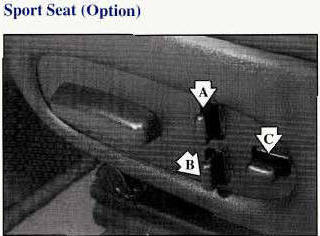
In addition to the power seat control, there are three other switches that help you change the shape of your seat. There are two lumbar supports (A and B) for the middle and lower back. There’s also a side bolster switch (C) that adjusts the sides of the seat around you to give you more lateral support.
For lumbar support, move switch (A and B) forward to inflate or rearward to deflate. Move the side bolster switch ( C ) up for more side support and down for less support.
The lever for the reclining seatback is located on the side of each seat, near the base. To adjust the seatback, pull up on the lever and tilt the seatback to where you want it. Release the lever to lock the seatback into place.
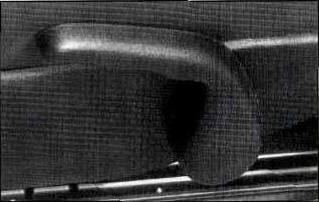
But don’t have a seatback reclined if your vehicle is
moving.CAUTION
Sitting in a reclined position when your vehicle is in motion can be dangerous. Even if you buckle up, your safety belts can’t do their job when you’re reclined.
The shoulder belt can’t do its job because it won’t be against your body. Instead, it will be in front of you. In a crash you could go into it, receiving neck or other injuries.
The lap belt can’t do its job either. In a crash the belt could go up over your abdomen. The belt forces would be there, not at your pelvic bones. This could cause serious internal injuries.
For proper protection when the vehicle is in motion, have the seatback upright. Then sit well back in the seat and wear your safety belt properly.
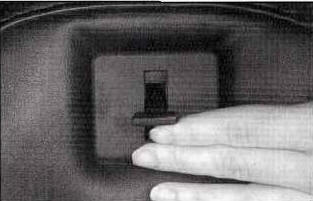
Both seatbacks fold forward to give you access to the rear area. To fold a seatback forward, lift this latch and pull the seatback forward. The seatback will lock down in this positionT. o unlock, lift up on the latch and push the seatback rearward. When you return the seatback to its original position, make sure the seatback is locked.
CAUTION
If the seatback isn’t locked, it could move forward in a sudden stop or crash. That could cause injury to the person sitting there. Always press rearward on the seatback to be sure it is locked.
This part of the manual tells you how to use safety belts properly. It also tells you some things you should not do with safety belts. And it explains the air bag system.
CAUTION
Don’t let anyone ride where he or she can’t wear a safety belt properly. If you are in a crash and you’re not wearing a safety belt, your injuries can be much worse. You can hit things inside the vehicle or be ejected from it. You can be seriously injured or killed. In the same crash, you might not be if you are buckled up. Always fasten your safety belt, and check that your passenger’s belt is fastened properly too.
Caution:
It is extremely dangerous to ride in a cargo area, inside or outside of a vehicle. In a collision, people riding in these areas are more likely to be seriously injured or killed. Do not allow people to ride in any area of your vehicle that is not equipped with seats and safety belts. Be sure everyone in your vehicle is in a seat and using a safety belt properly.
Your vehicle has a light that comes on as a reminder to buckle up.

(See “Safety Belt Reminder Light” in the Index.)
In most states and Canadian provinces, the law says to wear safety belts. Here’s why: They work.
You never know if you’ll be in a crash. If you do have a crash, you don’t know if it will be a bad one.
A few crashes are mild, and some crashes can be so serious that even buckled up a person wouldn’t survive. But most crashes are in between. many of them, people who buckle up can survive and sometimes walk away. Without belts they could have been badly hurt or killed.
After more than
30 years of safety belts in vehicles, the facts are clear. In most crashes buckling up does matter ... a lot!How to Wear Safety Belts Properly
Adults
This part is only for people of adult size.
Be aware that there are special things to know about safety belts and children. And there are different rules for smaller children and babies. If a child will be riding in your vehicle, see the part of this manual called “Children.” Follow those rules for everyone’s protection.
First, you’ll want to know which restraint systems your vehicle has.
We’ll start with the driver position.
This part describes the driver’s restraint system.
The driver has a lap-shoulder belt. Here’s how to wear it properly.
1. Close and lock the door.
2. Adjust the seat (to see how, see “Seats” in the Index) so you can sit up straight.
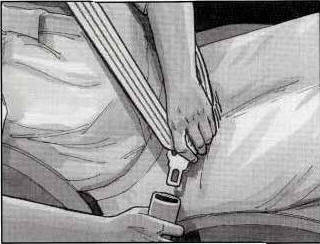
3. Pick up the latch plate and pull the belt across you.Don’t let it get twisted.
When the lap portion of the belt is pulled out all the way, it will lock. If it does, let it go back all the way and start again. See
“Lap Belt Cinch Feature” in the Index.4. Push the latch plate into the buckle until it clicks.
Pull up on the latch plate to make sure it is secure. If the belt isn’t long enough, see
“Safety Belt Extender” at the end of this section.Make sure the release button on the buckle is positioned so you would be able to unbuckle the safety belt quickly if you ever had to.
The lap part of the belt should be worn low and snug on the hips, just touching the thighs. In a crash, this applies force to the strong pelvic bones. And you’d be less likely to slide under the lap beIt
. If you slide under it, the belt would apply force at your abdomen. This could cause serious or even fatal injuries. The shoulder belt should go over the shoulder and across the chest. These poaf r ths e body are best able to take belt restraining forces.The safety belt locks if there’s a sudden stop or crash.
If you do not want the lap belt to move freely, pull the lap belt out all the way to set the lock. To permit the lap belt to move freely again, unbuckle the belt, let it retract all the way, and buckle up again.

To unlatch the belt, just push the button on the buckle. The belt should go back out of the way. Before you close the door, be sure the belt is out of the way. If you slam the door on it, you can damage both the belt and your vehicle.
Safety Belt Use During Pregnancy
Safety belts work for everyone, including pregnant women. Like all occupants, they are more likely to be seriously injured if they don’t wear safety belts.
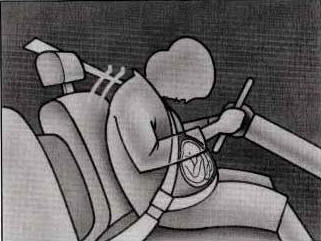
A pregnant woman should wear a lap-shoulder belt, and the lap portion should be worn as low as possible, below the rounding, throughout the pregnancy.
The best way to protect the fetus is to protect the mother. When a safety belt is worn properly, it’s more pregnant women, as for anyone, the key to making safety belts effective is wearing them properly.
To learn how to wear the passenger’s safety belt properly, see “Driver Position’’ earlier in this section.
The passenger’s safety belt works the same way as the driver’s safety belt -- except for one thing. If you ever pull the lap portion of the belt out all the way, you will engage the child restraint locking feature. If this happens, just let the belt go back all the way and start again.
This part explains the air bag system. Your vehicle has two air bags -- one air bag for the driver and another air bag for the passenger.
Here are the most important things to know about the air bag system:
Caution
You can be severely injured or killed in a crash if you aren’t wearing your safety belt, even if you have air bags. Wearing your safety belt during a crash helps reduce your chance of hitting things inside the vehicle or being ejected from it. Air bags are “supplemental restraints” to the safety belts. All air bags are designed to work with safety belts, but don’t replace them. Air bags are designed to work only in moderate to severe crashes where the front of your vehicle hits something. They aren’t designed to inflate at all in rollover, rear, side or low-speed frontal crashes. Everyone in your vehicle should wear a safety belt properly, whether or not there’s an air bag for that person
Caution:
Air bags inflate with great force, faster than the blink of an eye. If you’re too close to an inflating air bag, it could seriously injure you. Safety belts help keep you in position before and during a crash. Always wear your safety belt, even with in air bags. The driver should sit as far back as possible while still maintaining control of the vehicle.
Caution:
Children who are up against, or very close to, an air bag when it inflates can be seriously injured or killed. Air bags plus lap-shoulder belts offer the best protection for adults and older children, but not for young children and infants. Neither the vehicle’s safety belt system nor its air bag system is designed for them. Young children and infants need the protection that a child restraint system can provide. Always secure children properly in your vehicle. To read how, see the part of this manual called “Children” and see the caution labels on the sun visors and the passenger’s safety belt.
There is an air bag readiness light on the instrument panel, which shows the air bag symbol.
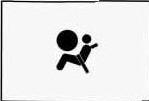
The system checks the air bag electrical system for malfunctions. The light tells you if there is an electrical problem. See “Air Bag Readiness Light” .
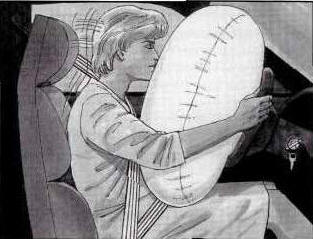
The driver’s
air bag is in the middle of the steering wheel.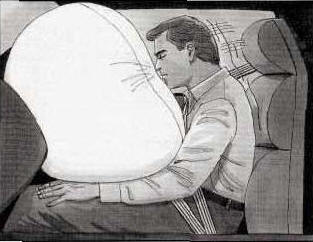
The passenger’s air bag is in the instrument panel on the passenger’s side.
CAUTION:
If something is between an occupant and an air bag, the bag might not inflate properly or it might force the object into that person. The path of an inflating air bag must be kept clear. Don’t put anything between an occupant and an air bag, and don’t attach or put anything on the steering wheel hub or on or near any other air bag covering.
When should an air bag inflate?
An air bag is designed to inflate in a moderate to severe frontal or near-frontal crash. The air bag will inflate only if the impact speed is above the system’s designed “threshold level.” If your vehicle goes straight into a wall that doesn’t move or deform, the threshold level is about 9 to 15 mph (14 to 24 km/h). The threshold level can vary, however, with specific vehicle design, so that it can be somewhat above or below this range. If your vehicle strikes something that will move or deform, such as a parked car, the threshold level will be higher. The air bag is not designed to inflate in rollovers, side impacts or rear impacts, because inflation would not help the occupant.
It is possible that in a crash only one of the two air bags in your Corvette will deploy. This is rare, but can happen in a crash just severe enough to make an air bag inflate.
In any particular crash, no one can say whether an air bag should have inflated simply because of the damage to a vehicle or because of what the repair costs were. Inflation is determined by the angle of the impact and how quickly the vehicle slows down in frontal or near-frontal impacts.
What makes an air bag inflate?
In an impact of sufficient severity, the air bag sensing system detects that the vehicle is in a crash. The sensing system triggers a release of gas from the inflator, which inflates the air bag. The inflator, air bag and related hardware are all part of the air bag modules inside the steering wheel and in the instrument panel in front of the passenger.
In moderate to severe frontal or near-frontal collisions, even belted occupants can contact the steering wheel or the instrument panel. Air bags supplement the protection provided by safety belts. Air bags distribute the force of the impact more evenly over the occupant’s upper body, stopping the occupant more gradually. But air bags would not help you in many types of collisions, including rollovers, rear impacts and side impacts, primarily because an occupant’s motion is not toward those air bags. Air bags should never be regarded as anything more than a supplement to safety belts, and then only in moderate to severe frontal or near-frontal collisions.
What will you see after an air bag inflates?
After an air bag inflates, it quickly deflates, so quickly that some people may not even realize the air bag inflated. Some components of the air bag module, the steering wheel hub for the driver’s air bag, or the instrument panel for the passenger’s bag
, will be hot for a short time. The parts of the bag that come into contact with you may be warm, but not too hot to touch. There will be some smoke and dust coming from vents in the deflated air bag. Air bags inflation doesn’t prevent the driver from seeing from being able to steer the vehicle, nor does it stop people from leaving the vehicle.NOTICE:
If you damage the covering for the driver’s or the passenger’s air bag, the bag may not work properly. You may have to replace the air bag module in the steering wheel or both the air bag module and the instrument panel for the passenger’s air bag. Do not open or break the air bag coverings.
Servicing Your Air Bag-Equipped Vehicle
Air bags affect how your vehicle should be serviced. There are parts of the air bag system in several places around your vehicle. You don’t want the system to inflate while someone is working on your vehicle. Your dealer and the Corvette Service Manual have information about servicing your vehicle and the air bag system. To purchase a service manual, see “Service and Owner Publications” in the Index.
Caution
When an air bag inflates, there is dust in the air. This dust could cause breathing problems for people with a history of asthma or other breathing trouble. To avoid this, everyone in the vehicle should get out as soon as it is safe to do so. If you have breathing problems but can’t get out of the vehicle after an air bag inflates, then get fresh air by opening a window or door.
Caution:
For up to10 minutes after the ignition key is turned off and the battery is disconnected, an air bag can still inflate during improper service. You can be injured if you are close to an air bag when it inflates. Avoid yellow wires, wires wrapped with yellow tape or yellow connectors. They are probably part of the air bag system. Be sure to follow proper service procedures, and make sure the person performing work for you is qualified to do so.
The air bag system does not need regular maintenance.
In many crashes severe enough to inflate an air bag, windshields are broken by vehicle deformation. Additional windshield breakage may also occur from the passenger air bag.
Air bags are designed to inflate only once. After they inflate, you’ll need some new parts for your air bag system. If you don’t get them, the air bag system won’t be there to help protect you in another crash. A new system will include air bag modules and possibly other parts. The service manual for your vehicle covers the need to replace other parts.
Your vehicle is equipped with a diagnostic module, which records information about the air bag system. The module records information about the readiness of the system, when the sensors are activated and driver’s safety belt usage at deployment.
Let only qualified technicians work on your air bag system. Improper service can mean that your air bag system won’t work properly.
Everyone in a vehicle needs protection! That includes infants and all children smaller than adult size. Neither the distance to be traveled nor the age and size of the traveler changes the need, for everyone, to use safety restraints.
In fact, the law in every state in the United States and in every Canadian province says children up to some age must be restrained while in a vehicle.Caution
Children who are up against, or very close to, an air bag when it inflates can be seriously injured or killed. Air bags plus lap-shoulder belts offer the best protection for adults and older children, but not for young children and infants. Neither the vehicle’s safety belt system nor its air bag system is designed for them. Young children and infants need the protection that a child restraint system can provide. Always secure children properly in your vehicle.
CAUTION:
A very young child’s hip bones are so small that a regular belt might not stay low on the hips, as it should. Instead, the belt will likely be over the child’s abdomen. In a crash, the belt would apply force right on the child’s abdomen, which could cause serious or fatal injuries. Smaller children and babies should always be restrained in a child restraint. However, infants, who should be restrained in a rear-facing child restraint, cannot ride safely in this vehicle. The instructions for the restraint will say whether it is the right type and size for your child. If a forward-facing child restraint is suitable for your child, be sure the child is always properly restrained while riding in this vehicle.
Infants need complete support, including support for the head and neck. This is necessary because an infant’s neck is
weak and its head weighs so much compared with the rest of its body. In a crash, an infant in a rear-facing restraint settles into the restraint, so the crash forces can be distributed across the strongest part of the infant’s body, the back and shoulders. A baby should be secured in an appropriate infant restraint, but you shouldn’t secure that type of restraint in this vehicle because of the air bag risk.

CAUTION:
Never hold a baby in your arms while riding in a vehicle. A baby doesn't weight much until a crash. During a crash a baby will become so heavy you can’t hold it. For example, in a crash at only 25 mph (40 km/h), a 12-lb. (5.5 kg) baby will suddenly become a 240-lb(1. 10 kg) force on your arms. The baby would be almost impossible to hold.
Every time infants and young children ride in vehicles, they should have protection provided by appropriate restraints.
Add-on child restraints are available in four basic types. When selecting a child restraint, take into consideration not only the child’s weight and size, but also whether or not the restraint will be compatible with the motor vehicle in which it will be used.
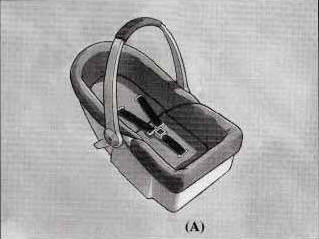
An
infant car bed (A) is a special bed made for use in a motor vehicle. It’s an infant restraint system designed to restrain or position a child an a continuous flat surface. With an infant car bed, make sure that the infant’s head rests toward the center of the vehicle.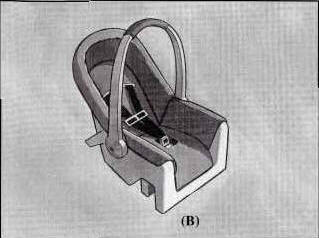
A rear-facing infant restraint (B) positions an infant to face the rear of the vehicle. Rear-facing infant restraints are designed for infants of up to about 20 lbs. (9 kg) and about one year of age. This type of restraint faces the rear so that the infant’s head, neck and body can have the support they need in a crash. Some infant seats come in two parts -- the base stays secured in the vehicle and the seat part is removable.
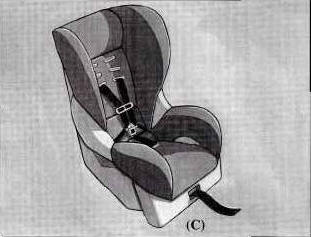
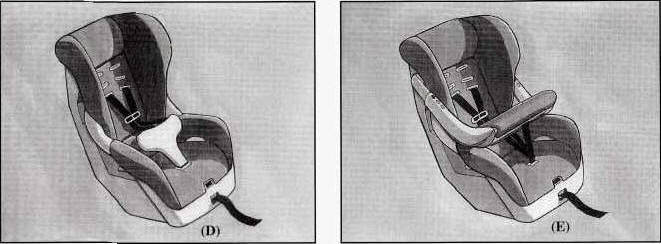
A
forward-facing child restraint( C-E) positions a child upright to face forward in the vehicle. These forward-facing restraints are designed to help protect children who are from 20 to 40 lbs. (9 to 18 kg) and about 26 to 40 inches (66 to 102 cm) in height, up or to around four years of age. One type, a convertible restraint, is designed to be used either as a rear-facing infant seat or a forward-facing child seat.When choosing a child restraint, be sure the child restraint is designed to be used in a vehicle. If it is, it will have a label saying that it meets Federal Motor Vehicle Safety Standards.
Then follow the instructions for the restraint. You may find these instruction so n the restraint itself or in a booklet, or both. These restraints use the belt system in your
vehicle, but the child also has to be secured within the restraint to help reduce the chance of personal injury. The instructions that come with the child restraint will show you how to do that. Both the owner’s manual and the child restraint instructions are important, so if either one of these is not available, obtain a replacement copy from the manufacturer.The child restraint must be secured properly in the passenger seat.
Keep in mind that an unsecured child restraint can move around in a collision or sudden stop and injure people in the vehicle. Be sure to properly secure any child restraint in your vehicle,
even when no child is in it.Some child restraints have a top strap. Don’t use a restraint like that in your vehicle because the top strap anchor cannot be installed properly. You shouldn’t use this type of child restraint without anchoring the top strap.
Securing a Child Restraint in the Passenger Seat Position
Your vehicle has a passenger air bag. Never put a
rear-facing child restraint in this vehicle. Here’s why:Caution
A child in a rear-facing child restraint can be seriously injured if the passenger’s air bag inflates. This is because the back of a rear-facing child restraint would be very close to the inflating air bag. Do not use a rear-facing child restraint in this vehicle.
If a forward-facing child restraint is suitable for your child, always move the passenger seat as far back as it will go.
You’ll be using the lap-shoulder belt. See the earlier part about the top strap if the child restraint has one. Be sure to follow the instructions that came with the child restraint. Secure the child in the child restraint when and as the instructions say.
Because your vehicle has a passenger air bag, always move the seat as far back as it will go before securing a forward-facing child restraint. (See “Seats” in the Index.)
Put the restraint on the seat.
Pick up the latch plate, and run the lap and shoulder portions of the vehicle’s safety belt through or around the restraint. The child restraint instructions will show you how. If the shoulder belt goes in front of the child’s face or neck, put it behind the child restraint.
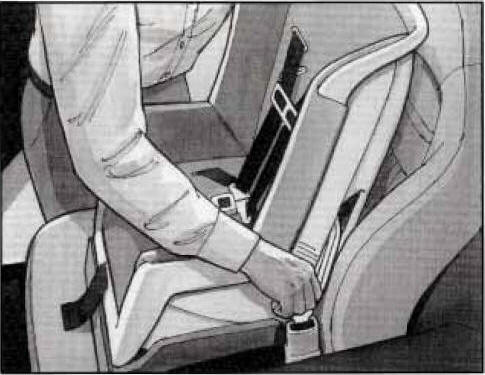
Buckle the belt. Make sure the release button is positioned so you would be able to unbuckle the safety belt quickly if you ever had to.
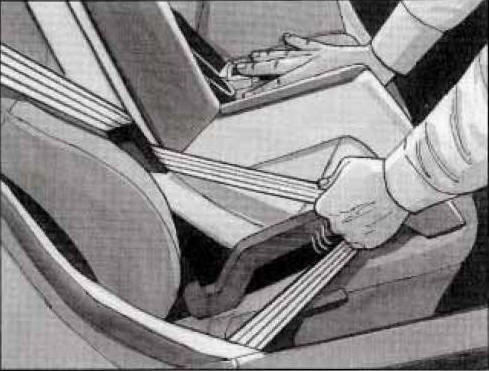
Pull the rest of the lap belt all the way out of the retractor to set the lock.

To tighten the belt, feed the lap belt back into the retractor while you push down on the child restraint. You may find it helpful to use your knee to push down on the child restraint as you tighten the belt.
Push and pull the child restraint in different directions to be sure it is secure.
To remove the child restraint, just unbuckle the vehicle's safety belt and let it go back all the way. The safety belt will move freely again and be ready to work for an adult or larger child passenger.
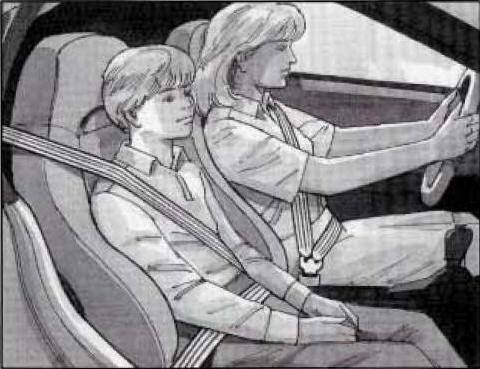
Children who have out grown child restraints should wear the vehicle's safety belts.
Children who aren't buckled up can be thrown out in a crash.
Children who aren't buckled up can strike other people who are.
Never do this.
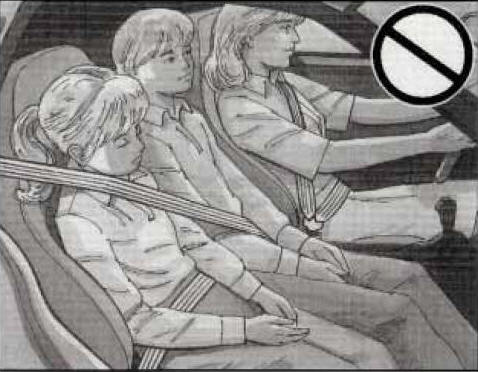
Here two children are wearing the same belt. The belt can't properly spread the impact forces. In a crash, the two children can be crushed together and seriously injured. A belt must be used by only one person at a time.
If a child is wearing a lap-shoulder belt, but the child is so small that the shoulder belt is very close to the child's face or neck, move the child toward the center of the vehicle. Be sure that the shoulder belt still is on the child's shoulder, so that in a crash the child's upper body would have the restraint that belts provide.
Never do this.
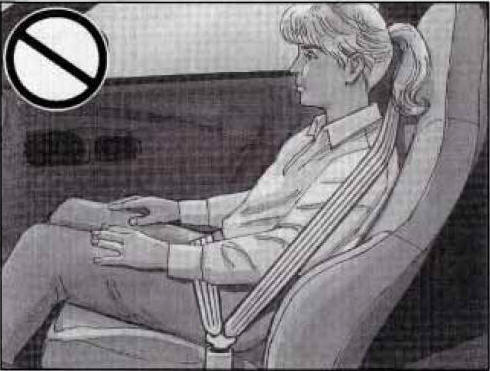
Here a child is sitting in a seat that has a lap-shoulder belt, but the shoulder part is behind the child. If the child wears the belt in this way, a crash the child might slide under the belt. The belt’s force would then be applied right on the child’s abdomen. That could cause serious or fatal injuries.
The lap portion of the belt should be worn low and snug on the hips, just touching the child’s thighs. This applies belt force to the child’s pelvic bones in a crash.
If the vehicle’s safety belt will fasten around you, you should use it.
But if a safety belt isn’t long enough to fasten, your dealer will order you an extender. It’s free. When you go in to order it, take the heaviest coat you will wear so the extender will be long enough for you. The extender will be just for you, and just for the seat in your vehicle that you choose. Don’t let someone else use it, and use it only for the seat it is made to fit. To wear it, just attach it to the regular safety belt.
Checking Your Restraint Systems
Now and then, make sure the safety belt reminder light and all your belts, buckles, latch plates, retractors and anchorages are working properly. Look for any other loose or damaged safety belt system parts.
If you see anything that might keep a safety belt system from doing its job, have it repaired.Torn or frayed safety belts may not protect you in a crash. They can rip apart under impact forces. If a belt is torn or frayed, get a new one right away.
Also look for any opened or broken air bag covers, and have them repaired or replaced. (The air bag system does not need regular maintenance.)
Replacing Restraint System Parts After a Crash
If you’ve had a crash, do you need new belts?
After a very minor collision, nothing may be necessary. But if the belts were stretched, as they would be if worn during a more severe crash, then you need new belts.
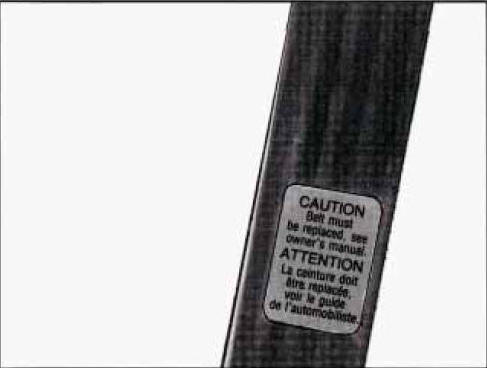
If you ever see a label on the driver’s or passenger’s safety belt that says to replace the belt, be sure to do so. Then the new belt will be there to help protect you in a collision. You would see this label on the belt near the latch plate.
If belts are cut or damaged, replace them. Collision damage also may mean you will need to have safety belt or
seat parts repaired or replaced. New parts and repairs may be necessary even if the belt wasn’t being used at the time of the collision.If
an air bag inflates, you’ll need to replace air bag system parts. See the part on the air bag system earlier in this section.